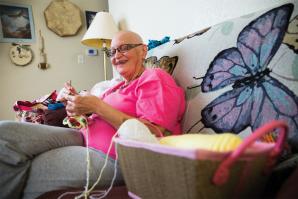For Lori Raineri, getting from place to place is a team effort involving both human and canine commitment.
As president of the consulting firm Government Financial Strategies Inc. in Sacramento, Raineri regularly travels across California and the country. While that’s not unusual for a busy executive, the energetic Raineri has a non-negotiable caveat: She and her service dog, Daisy — a border collie mix who readily offers her own business card and has a penchant for stuffed animals — must use public transportation and their own feet whenever and wherever possible.
“I find my car to be a very confining psychological experience these days,” she says.
Raineri has not always felt like this. Like most of us, she once spent hours a day in her car, which, thanks to her cell phone, doubled as a rolling office. It was, she says, a very stressful existence.
“Even so, it just never occurred to me to not drive my car,” she says.
That started to change in 2009 when she suffered her second bout with a rare form of cancer. Radiation made her too weak to drive, so her doctor set her up with a bus that goes from the university campus near her home in Davis to the UC Davis Medical Center in Sacramento where she was receiving treatment. The trip also involved lots of walking, which she says greatly aided her recovery. She was eventually strong enough to drive again but had lost the desire. A devotee to public transportation was born.
But it is not always easy. Raineri relies heavily on her assistant, Maureen O’Connor-Travis, to coordinate the plethora of bus, plane and train schedules and routes necessary to get her to her various distant locales. It took time for O’Connor-Travis to learn the various systems and even more time to get comfortable with the unfamiliar areas she would be sending Raineri and Daisy through on foot. Even now, O’Connor-Travis says she will not send Raineri anywhere on Greyhound because the stations often are in rough areas.
And even with all the planning and willingness to hoof it, Raineri acknowledges that sometimes a destination is simply out of reach without some kind of car travel. For that, she has a person on staff whose job description includes the occasional “pick me up.” She also lauds taxis, which she calls “essential” to making her system work, and she will frequently stay over in a hotel if her meeting schedule doesn’t jibe with local evening transit.
Raineri knows that other aspects of her life also contribute to her public transportation success. She doesn’t have kids to tend with, for instance, and she has the means to spend whatever is necessary to get where she is going, which she calls “putting my money behind my beliefs.”
Even with the various challenges, Raineri says her public transportation conversion is permanent.
“I feel far more empowered on public transportation,” she says, noting it’s also one place she’s never run into hassles over having Daisy with her.
She notes another, somewhat ironic, perk: “When I was driving everywhere, I was notorious for being late to everything, and then I was totally flustered when I finally got there,” she says. “Now, because I have to plan so much better, I am a completely on-time person.”
Recommended For You

Driving Donations
Transportation support for cancer patients in need
Dorothy Hillbrant, who has stage III ovarian cancer, became one of about 30 local drivers for the American Cancer Society’s Road to Recovery Program, which has provided free rides to treatment for patients and their caregivers for about 30 years.

Streetcar Named Desire
Funding questions loom over downtown streetcar project
For nearly two decades, local city officials have envisioned a streetcar that would transport residents and visitors across downtown Sacramento.


